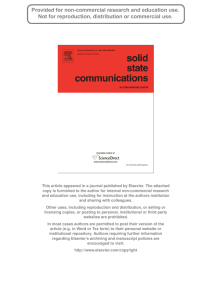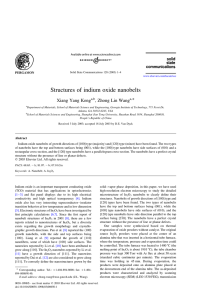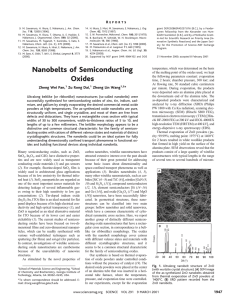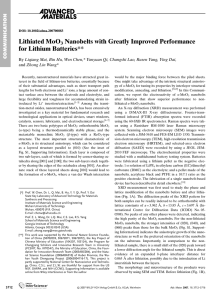Supplementary Information Tunable growth of silver nanobelts on
advertisement
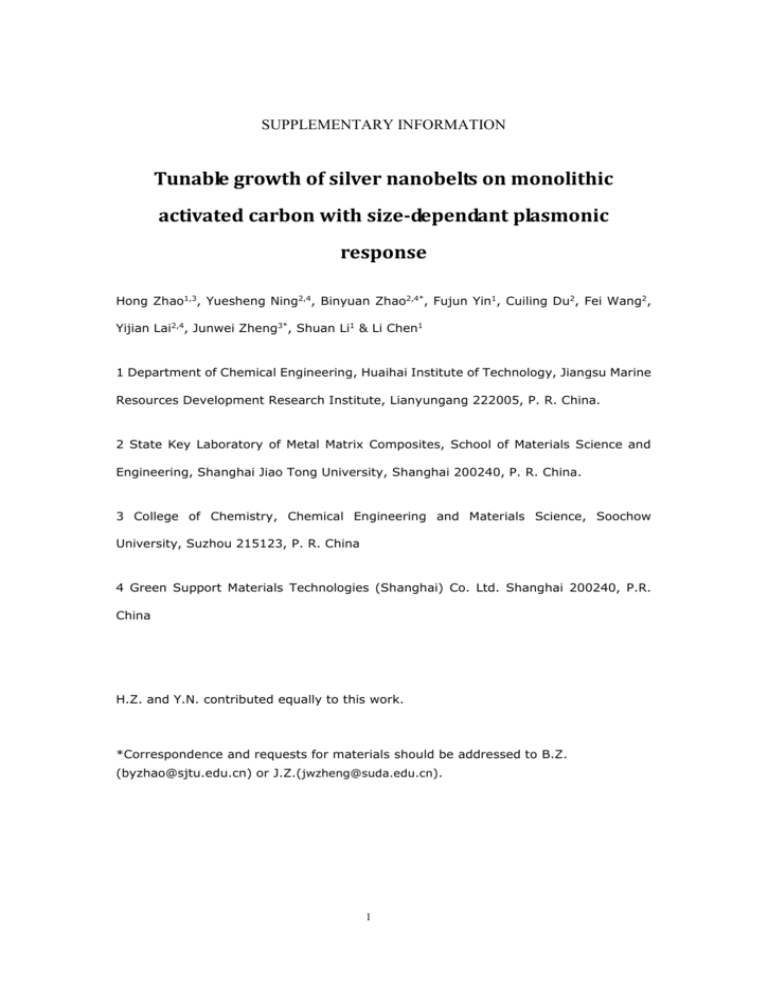
SUPPLEMENTARY INFORMATION
Tunable growth of silver nanobelts on monolithic
activated carbon with size-dependant plasmonic
response
Hong Zhao1,3, Yuesheng Ning2,4, Binyuan Zhao2,4*, Fujun Yin1, Cuiling Du2, Fei Wang2,
Yijian Lai2,4, Junwei Zheng3*, Shuan Li1 & Li Chen1
1 Department of Chemical Engineering, Huaihai Institute of Technology, Jiangsu Marine
Resources Development Research Institute, Lianyungang 222005, P. R. China.
2 State Key Laboratory of Metal Matrix Composites, School of Materials Science and
Engineering, Shanghai Jiao Tong University, Shanghai 200240, P. R. China.
3 College of Chemistry, Chemical Engineering and Materials Science, Soochow
University, Suzhou 215123, P. R. China
4 Green Support Materials Technologies (Shanghai) Co. Ltd. Shanghai 200240, P.R.
China
H.Z. and Y.N. contributed equally to this work.
*Correspondence and requests for materials should be addressed to B.Z.
(byzhao@sjtu.edu.cn) or J.Z.(jwzheng@suda.edu.cn).
1
Supplementary Figure S1 ︱ A typical tapping mode AFM image of a silver
nanobelt with section analysis. The red marker yields a vertical distance (i.e.
thickness of the nanobelt) of 13.607 nm.
2
1.2
(b)
1456
1.0
Extinction
0.8
0.6
474
0.4
336
0.2
0.0
400
600
800
1000
1200
1400
1600
wavelength (nm)
Supplementary Figure S2 ︱Yellow silver nanobelts grown on MAC. (a) Digital
Photograph, (b) extinction spectrum corresponding to the yellow silver nanobelts in (a).
3
(222)
(311)
(220)
(200)
red
10000
Intensity (a.u.)
(111)
(a)
(V)
purple
(IV)
blue pruple
(III)
5000
submicro belt
(II)
plate
(I)
0
10
20
30
40
50
60
70
80
90
2 ()
0.050
red nanobelt
(b)
purple nanoblet
0.045
I200/I111
0.040
0.035
blue purple nanoblet
0.030
submicro belt
0.025
plate
0.020
(I)
(II)
(III)
(IV)
(V)
Supplementary Figure S3 ︱XRD analysis of silver products. (a) XRD pattern
of
five silver samples prepared on MAC, (b)(200)/(111) peak height ratio corresponding to
(a). The (I) plate and (II) micro-belt samples were prepared as described in our previous
work1. Samples (III), (IV) and (V) have the same color appearance as samples #2, #5
and #3, respectively, as shown in Figure 3.
4
XRD spectra of five silver samples prepared on MAC are presented in Supplementary Fig. S3a.
All of them have five clean peaks and can be indexed to the (111), (200), (220), (311) and (222)
characteristic planes of face centered cubic (fcc) silver, which match well with the standard pattern
of silver (JCPDS, NO. 04-0783). According to a structural model depicted by Wang2,3 , the basal
surfaces of Ag nanobelts, triangle nanoprisms and hexagonal nanoplates are {111} planes, and
each of their side surfaces consists of two {100} planes joined by a stacking fault ridge (or
groove). So the {111}/{100} height ratio should be positively correlated to the width/thickness
ratio. The (200)/(111) peak height ratio (inverse to the above-mentioned {111}/{100} ratio)
derived from Supplementary Fig. 3a is plotted in Supplementary Fig. S3b. The red, purple and
blue-purple nanobelts, which possess consecutively higher width/thickness ratio as listed in Table
1, exhibit lower (200)/(111) height ratio in order. This result further confirms that the red-shift in
transversal plasmon peaks in the extinction spectra is actually caused by the increase in the
width/thickness ratio4.
Supplementary References
1. Zhao, H. et al. “Green “planting” nanostructured single crystal silver”. Sci. Rep. 3, 1511,
(2013) .
2. Wang, Z.L. Transmission Electron Microscopy of Shape-Controlled Nanocrystals and Their
Assemblies, J. Phys. Chem. B 104, 1153-1175, (2000).
3. Le Beulze, A. et al. New Insights into the Side-Face Structure, Growth Aspects, and
Reactivity of Agn Nanoprisms, Langmuir 30, 1424-1434 (2014).
4. Anderson, L.J. E., Payne, C.M., Zhen, Y.R., Nordlander, P., Hafner, J.H. A Tunable Plasmon
Resonance in Gold Nanobelts, Nano Lett. 11, 5034–5037 (2011).
5








